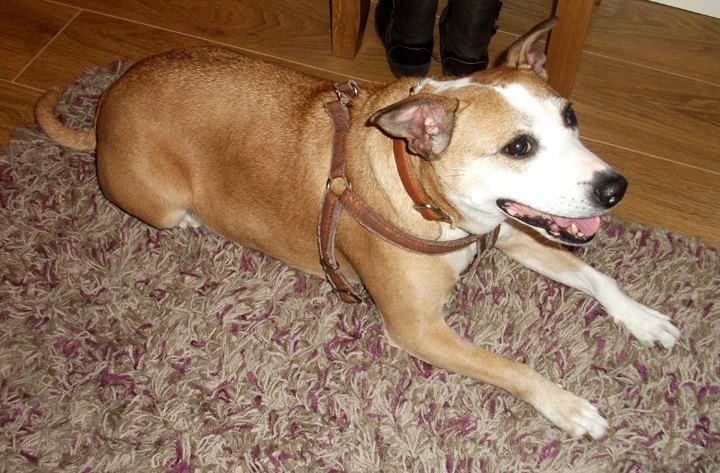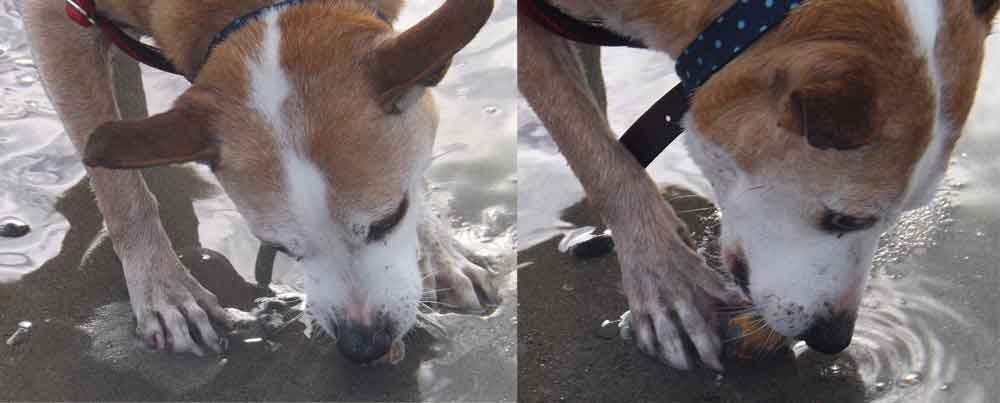It’s with considerable sadness that I’m writing this within days of the death of Willow, the older of my family’s two dogs. Willow was 14 years old and had been with us since February 2013. Her loss has hit me far harder than I thought it would. I should have taken the week off work.
Willow on the day we brought her home (though here at my mother-in-law’s house) in February 2013. She has a really foxy look in this photo.
Willow was a mixed breed dog who was definitely part staffie (Staffordshire bull terrier), the other half of her ancestry probably involving Jack Russell. She was handsome, sleek and with an attractive two-tone colour scheme, though she was initially a bit overweight and had to be slimmed down with a diet. She was smart and could solve simple problems used to test dog intelligence (like escaping from beneath a blanket) extremely quickly, and her attachment to our family unit meant that she would refuse to move on if one or more of us was dawdling behind. She appeared to be concerned if either of the children moved too far away from the group and would circle round to gather them up. She followed basic commands and Toni (my wife) could get Willow to give a distinct three-part bark on command: it sounded like “I love you!”. She was playful and especially enjoyed tug-of-war and attempting to grab her own tail, her jaws closing with an audible snap as she spun in a circle.
Willow was a rescue dog who, for reasons unknown to us, had been given to a charity (the Blue Cross) by a family who had several dogs and children. We assume that hard times or changing conditions forced that family to give her away, and also that this history was the cause for what appeared to be chronic fear of abandonment: for the first several months of her life with us, Willow would whine loudly (really loudly) when left alone outside shops or other places where dogs can’t be taken. The sound was more of a repetitive screaming wail than a whine, and I sometimes had to assure people nearby that it was this fear that explained her loud complaints. She lost this habit in time, presumably once it was obvious to her that we would never leave her. Whatever her history, she came to us fully trained, wholly used to being walked on the lead, and absolutely compatible with family life. It would have been an absolute tragedy had she never been claimed by new owners and euthanized before her time.
At left: Willow (with rope toy) waits for commands from Toni; a photo from 2014. At right: a trip to the beach.
The condition of her teats led us to think that she had probably become a mother at some earlier point in her life, but we never had a way of confirming this. She came to us un-neutered, something we fixed as soon as we took ownership of her. Her behaviour with puppies seemed to back up a history of being a mum. When confronted in 2017 with Teddy, our West Highland terrier pup, she took immediately to the role of surrogate mum, enthusiastically cleaning him and allowing him to share her bed for all the time that he was a small puppy. Her tolerance with Teddy – a brand-new dog who always wanted (and still wants) to play, to tussle, to engage in rough-and-tumble and to generally get up to mischief – never ceased to amaze me.
Willow proved to be an excellent carer of Teddy, who was initially a tiny pup. This photo is from September 2017.
In fact, Willow’s response to other animals of all sorts was interesting. She never viewed other pets – including our guinea-pigs or Flame the bearded dragon – with predatory interest. At the risk of gross anthropomorphising, her character and personality was one of infinite patience, kindness, tolerance and forgiveness. I cannot forget the times I scolded her or was impatient or angry with her. She always seemed to forgive me, but I regret these things very much and have vowed to be kinder and more tolerant to Teddy and other dogs. Remember this if you live with a dog yourself.
I don’t know if it would be right to describe Flame and Willow as friends, but they certainly tolerated each other. Flame sometimes climbed on Willow’s back.
Willow got to spend lots of time outdoors and I’m glad that we took her on as many trips, excursions and holidays as we did. The photos of her running about in the woods and on beaches make me happy, especially when her expressions and body language make it look as if she was really enjoying herself.
That hilarious look on her face as she runs - the trademark ‘Staffie grin’.
She liked wading and would often walk into pools, large puddles or the sea, though she never wanted to go deep enough for a swim. She frequently became very muddy on trips to shorelines and damp forests. She loved to run and did so with a hilarious and comical open-mouthed grin. While never wantonly destructive of property or furniture, she loved ripping open and then destroying toys purchased as presents, her aim at Christmas being – seemingly – to rip a dog toy into small fragments within ten minutes of ownership. She hated baths and I would have to thwart her efforts to escape.
Christmas 2013, and Willow proves to be an expert at breaking open Christmas presents.
From a zoological, behavioural point of view, several aspects of her behaviour were interesting. After peeing, she would scrape backwards, forcefully, with both hindfeet and leave prominent scores on the ground. This is a great way to gradually kill and destroy a lawn. Her decision to break open and consume deceased whelks on a beach surprised me, though maybe it shouldn’t have.
Ichnology of a domestic mammal. Prominent claw scrape marks made by Willow, 2014.
The strandline of West Wittering beach, on this occasion, was littered with dead whelks which Willow took to cracking open and eating.
The final part of Willow’s story is a sad one of rapid and startling decline. It became obvious by late 2018 that Willow was losing condition, and unable to regain it. She became distressingly, skeletally thin, despite a good diet, and her muscles withered. Standing appeared painful, her tail was kept perpetually down and pressed close to her rear end, and she was often unable to support her weight, her legs giving way and causing collapse. Trips to the vets and medicines administered for joint health and so on helped for a while. She became incontinent, very obviously suffered from failed hearing, and took to repetitive, excessive pacing about the house, this perhaps being a sign of dementia. The Willow I’m describing is not the dog shown in the photos here, but a smaller, diminished animal, approaching death.
At left: on a 2014 holiday in the Brecon Beacons, Wales. At right: in the New Forest, 2013.
What have I learned from life with a dog as kind, gentle and wonderful as Willow? To be kinder, more patient and more tolerant to dogs and other animals... when they’re gone, you’ll regret the times you were less of these things. To take more photos when times are good, since you’ll never have enough by the time it’s too late. To take time to express love and affection when you can. And to not underestimate the emotional attachment you might have to your fellow creatures.
This photo was taken on a fieldtrip where my son Will and I went to see deer.
Willow left us on Monday 20th May 2019. When we took ownership of her in 2013, she was thought to be 8 years old, meaning that she was 14 when she died. I miss her so much. Thank you, Willow, for being such an excellent dog and thank you for teaching me so much.
Willow the dog leads Will and Emma the humans.
















